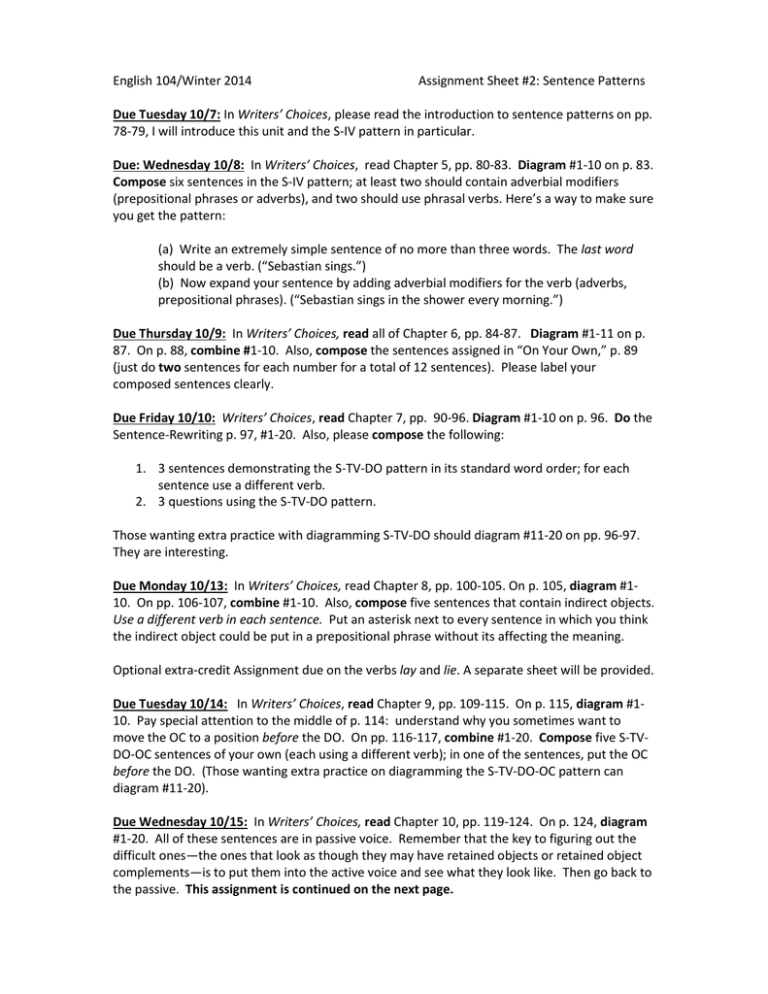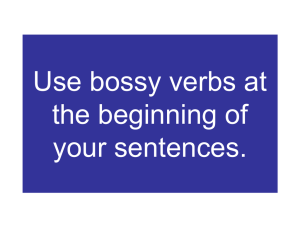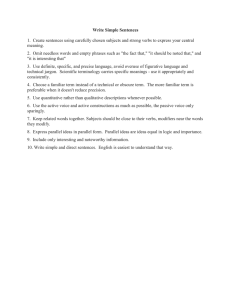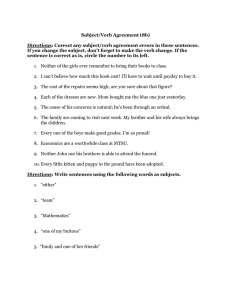English 104/Winter 2014 Assignment Sheet #2: Sentence Patterns
advertisement

English 104/Winter 2014 Assignment Sheet #2: Sentence Patterns Due Tuesday 10/7: In Writers’ Choices, please read the introduction to sentence patterns on pp. 78-79, I will introduce this unit and the S-IV pattern in particular. Due: Wednesday 10/8: In Writers’ Choices, read Chapter 5, pp. 80-83. Diagram #1-10 on p. 83. Compose six sentences in the S-IV pattern; at least two should contain adverbial modifiers (prepositional phrases or adverbs), and two should use phrasal verbs. Here’s a way to make sure you get the pattern: (a) Write an extremely simple sentence of no more than three words. The last word should be a verb. (“Sebastian sings.”) (b) Now expand your sentence by adding adverbial modifiers for the verb (adverbs, prepositional phrases). (“Sebastian sings in the shower every morning.”) Due Thursday 10/9: In Writers’ Choices, read all of Chapter 6, pp. 84-87. Diagram #1-11 on p. 87. On p. 88, combine #1-10. Also, compose the sentences assigned in “On Your Own,” p. 89 (just do two sentences for each number for a total of 12 sentences). Please label your composed sentences clearly. Due Friday 10/10: Writers’ Choices, read Chapter 7, pp. 90-96. Diagram #1-10 on p. 96. Do the Sentence-Rewriting p. 97, #1-20. Also, please compose the following: 1. 3 sentences demonstrating the S-TV-DO pattern in its standard word order; for each sentence use a different verb. 2. 3 questions using the S-TV-DO pattern. Those wanting extra practice with diagramming S-TV-DO should diagram #11-20 on pp. 96-97. They are interesting. Due Monday 10/13: In Writers’ Choices, read Chapter 8, pp. 100-105. On p. 105, diagram #110. On pp. 106-107, combine #1-10. Also, compose five sentences that contain indirect objects. Use a different verb in each sentence. Put an asterisk next to every sentence in which you think the indirect object could be put in a prepositional phrase without its affecting the meaning. Optional extra-credit Assignment due on the verbs lay and lie. A separate sheet will be provided. Due Tuesday 10/14: In Writers’ Choices, read Chapter 9, pp. 109-115. On p. 115, diagram #110. Pay special attention to the middle of p. 114: understand why you sometimes want to move the OC to a position before the DO. On pp. 116-117, combine #1-20. Compose five S-TVDO-OC sentences of your own (each using a different verb); in one of the sentences, put the OC before the DO. (Those wanting extra practice on diagramming the S-TV-DO-OC pattern can diagram #11-20). Due Wednesday 10/15: In Writers’ Choices, read Chapter 10, pp. 119-124. On p. 124, diagram #1-20. All of these sentences are in passive voice. Remember that the key to figuring out the difficult ones—the ones that look as though they may have retained objects or retained object complements—is to put them into the active voice and see what they look like. Then go back to the passive. This assignment is continued on the next page. Wednesday 10/15 continued: Also, do Making Passive Voice Sentences, p. 124-125 (the ten sentences beginning with “Laticia ate the sandwich rapidly”) and Using Passive Voice to Improve Coherence #1-5, pp. 125-126 (an exercise that makes a very valuable point about the value of using the passive voice in certain cases). There are answer keys to both of these exercises. Compose a pair of sentences like those in the exercise—one sentence followed by a second sentence in which passive voice is used to achieve coherence with the first sentence. Finally, do On Your Own, p. 126. Just do three sentences for each question (six sentences total). Due Thursday 10/16: Today we start a two-day review for Test #2, which will be Tuesday, 2/4, and will cover the five sentence patterns we have studied as well as passive transformations of the transitive verb patterns. For homework: 1. Bring four short lists of verbs as follows: a. 5 linking verbs b. 5 verbs that commonly take indirect objects c. 5 verbs that commonly take object complements d. 3 verbs that can be both intransitive and transitive e. The one verb that is always present in the passive voice. 2. Compose two sentences for each of the following verbs: run, shrink, search, serve, and turn. In one sentence, use the verb intransitively; in the other, use it transitively and circle its direct object. You may use the verbs in any tenses you choose. 3. Optional special extra credit opportunity for artist-grammarians! Create two pictures illustrating the difference between the following two sentences, each of which uses the verb “make” to create a different sentence pattern. (And I’m sorry for the gender stereotypes!) a. Dracula’s mother made Dracula his midnight snack. b. Dracula’s sister made Dracula her midnight snack. 4. Please diagram the following sentences (no answer key): a. We have gotten a new kitten from the animal shelter. b. This kitten will be a companion for our old cat. c. The person at the shelter listed the qualities of this darling kitten. d. The kitten is playful, and was given to the shelter by a rock musician. e. We will name the kitten “Didion” or “Burrito.” f. I will send you a photo of it. g. She is a girl kitten, and she looks very cute. h. Our old cat finds her frightening. i. I consider her sweet and funny. Due Friday 10/17: Do the sample test on pp. 127-128. We will go over the answers in class. Monday 10/20: Test #2. Remember that you may bring a page of notes to the test. They must be handwritten, on one side only of an 8 1/2” by 11” sheet. You may also bring a paper Englishto-English dictionary.


